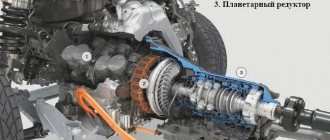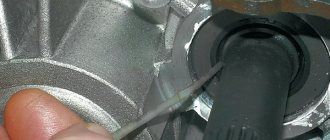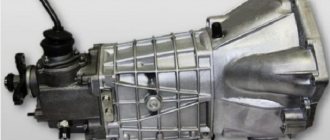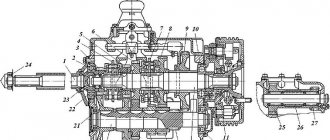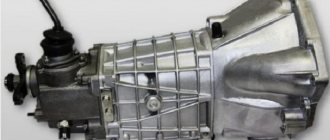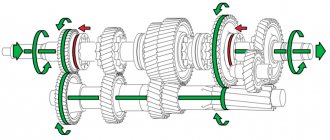Automatic transmission diagnostics yourself
What should you pay attention to before buying a car with automatic transmission?
Driving a car with an automatic transmission is very comfortable and convenient. But the cost of a new car with such a transmission is slightly higher than its manual counterpart. Therefore, car enthusiasts often turn to buying a used car. In this situation, you need to be very careful and know how to check the automatic transmission before buying a car . Here are some tips to remember and avoid purchasing if:
If you don’t want to buy a pig in a poke, we recommend conducting a thorough computer diagnostic of the automatic transmission at a specialized car service center.
Causes of automatic transmission failure
Failure of an automatic transmission can be caused by various reasons, which can be combined into several related points:
— malfunction of the control cable due to incorrect adjustment or souring;
— breakdown of the hydraulics or mechanical part of the system;
— wear of friction discs;
— electronics malfunction (for example, control unit);
— violation of the general settings of the automatic transmission.
If the transmission begins to function abnormally, or there are suspicions that it is broken, then an immediate check of the automatic transmission . The sooner the cause is identified, the less expensive the repair will be.
Transmission diagnostics. How to check the automatic transmission?
We tried to collect in one article all the diagnostic procedures that will help you figure out what exactly went wrong in the automatic transmission. We recommend searching for a breakdown of the machine in the following sequence:
Checking the oil level and condition
Before we begin this procedure, let's take a closer look at how to check the oil in an automatic transmission. In fact, there is nothing complicated about it. We start the car engine and switch the gearbox selector to the “P” (parking) position. While the car is idling, check the oil. We take out the dipstick, wipe it and insert it back. After this, take out the dipstick again and look at the oil level. Now you need to wipe the dipstick with white paper. There should be no traces of metal shavings or other foreign microelements on the paper sheet. If the oil has darkened (ideally it should be red), it means that it has not been changed for a long time. On some modern car models with automatic transmission, this dipstick is missing. In such a situation, you can check the level and condition of the oil only at a car service center.
Checking the level and condition of the fluid in the automatic transmission | Video
Checking the adjustment cable
The next stage of automatic transmission diagnostics is checking the throttle valve control cable or, as it is also called, the adjusting cable. During operation of the gearbox, the adjusting cable wears out, which leads to disruption of the entire transmission. In particular, the need to adjust the cable is indicated by premature gear shifting at high or low speeds. As a result, wear on the main components of the box increases, and fuel consumption also increases. The cable may need to be lubricated or tightened if it is loose.
How to check an automatic transmission with a stationary car
We recommend that this procedure be carried out in the presence of a qualified specialist.
The so-called Stall Test is carried out on a completely braked car, with the engine running at maximum power. As a result of this test, it is possible to evaluate the braking properties of friction discs, the quality of operation of the torque converter and the engine as a whole. Before checking, you must make sure that the car is securely braked. Set the automatic transmission selector to position “P”, and also turn on the main and auxiliary brakes. Also, secure the wheels with some kind of chocks. During the inspection, there should be no people in front or behind the vehicle.
This test will not take much time. To check the automatic transmission, you must perform the following steps:
If during this procedure there are unusual extraneous noises in the engine operation, then the test must be stopped immediately.
After this, it is necessary to compare the obtained indicators with the values set by the manufacturer. If the number of revolutions exceeds the manufacturer's specifications, then the problem is likely low pressure in the main line. If, on the contrary, the number of revolutions does not reach the recommended value, then, most likely, the free-motion clutch of the torque converter reactor has become unusable.
How to check the automatic transmission while the car is moving
Road tests are one of the most important tools for automatic transmission diagnostics. During this test, the following transmission performance indicators are checked:
— timely gear shifting;
— no jerking when moving;
— the presence of third-party noise or vibrations under the hood;
— correct operation of the box in various driving modes;
— timely response of the box, no slipping.
If, as a result of this check, slipping of the car or an unexpected increase in engine speed when changing gears was revealed, then, most likely, the friction discs have become unusable or there is a problem in the freewheel.
How to check the automatic transmission when buying a used car?
If a vehicle is purchased secondhand, then it is necessary to interview its owner about the vehicle. In particular, when was the last time the maintenance was performed, how many owners did the vehicle being sold have? Also, to avoid getting a “pig in a poke”, find out:
- whether any repairs have ever been carried out;
- Are there any outstanding fines?
How to check the automatic transmission when buying a car? When purchasing a vehicle, you should visually inspect the condition of the box. It is advisable to start the engine so that the car warms up, after which you need to open the hood and inspect the gearbox (from above, under the bottom). There should be no fuel leaks on this unit.
If the car has a dipstick, then with its help it is possible not only to determine the existing fuel level, but also the quality of the filled oil. The liquid should be odorless and black. Operating a vehicle with used oil leads to premature wear of the component parts of the box. Oil in normal condition should not run off the dipstick like water.
Serious labor costs can arise if metallic particles are found in the oil, even if the liquid is light in color. The presence of these additives is evidence that the gearbox mechanisms are worn out, i.e. will soon lose their functional properties. The presence of a burning smell indicates a problem with the friction discs.
The automatic transmission must be checked while driving on the road. You should also inspect your car's tires.
How to check the automatic transmission on a car
Today, an automatic transmission is much more in demand than a traditional manual transmission for a variety of reasons. First of all, the automatic transmission allows you to change gears without driver intervention, which significantly increases comfort and safety.
Taking into account the fact that an automatic transmission is a complex and expensive unit, the cost of a car with such a transmission is, on average, 15-25% higher than a similar model with a manual transmission. It turns out, given the difficult economic situation, not everyone in the CIS is able to buy a new car, especially one with an automatic transmission.
For this reason, when buying a used car, you need to carry out in-depth diagnostics of all components and assemblies, and also know how to check the automatic transmission. Next, we will talk about how to quickly check the machine on a car, which allows you to decide whether it is worth further considering this or that option for purchase.
How to check the automatic transmission when buying a car
Buying a used car is a real art that requires certain knowledge and luck. It is extremely rare that the owner of a car reports all its problems, and often he himself does not know about many of them.
One of the most expensive components of a car is the gearbox. When purchasing a car from a former owner, it is recommended to involve specialists who can diagnose the body, engine, suspension and transmission, among other things. But there are times when it is not possible to inspect the car with professionals. In such a situation, the driver must carefully diagnose all units, including the automatic transmission. Below we will tell you how to check the automatic transmission on a used car.
How to check the serviceability of the automatic transmission during the initial inspection
Let us immediately note that checking the automatic transmission is the most important step when selecting a used car. A common and widespread mistake is to check only the engine of a used car, assess the condition of the body, identify hidden damage after an accident, etc. At the same time, due attention is not paid to the transmission for one reason or another.
It is important to understand that when buying a used car, the automatic transmission must be carefully checked. The fact is that repairing an automatic transmission may be more expensive than overhauling an internal combustion engine or some types of body work.
Of course, you can immediately go to a service station for diagnostics on every car you like, but in this case, the loss of time and the costs of selecting a suitable option will increase significantly. For this reason, you need to know how to check the automatic transmission right on the spot. So, let's go!
What to pay attention to when talking with a seller
First of all, the service life of the automatic transmission is greatly influenced by the quality of service and operating features. In simple words, you need to understand how the previous owner maintained the machine. There are a few basic questions to ask:
It is also important to ask the seller to actually confirm the information he provides (presence of a service book with marks, work orders, certificates of work performed, receipts, etc.).
In cases where the car’s mileage is not high (for example, a car with a “classic” automatic transmission and a real mileage of 120-130 thousand km), and the automatic transmission has not been repaired and has been comprehensively serviced every 50-60 thousand km, then the likelihood of a working condition transmission condition is quite high.
The main thing is that original transmission fluids or high-quality analogues are used, and that the automatic transmission filter is regularly changed. In this case, the wave box may be in good condition and have an acceptable residual life (about 40-50%).
However, if the seller has driven 80-90 thousand km. and just changed the oil before selling (the oil on the dipstick is clean and transparent), or the oil has not been changed and the owner claims that the automatic transmission is not serviced, then this is a reason for a serious check of the automatic transmission on a particular car, a reasonable bargain, or a complete refusal to purchase.
We will also add that you need to ask a question regarding how the car was used. You should pay special attention to indirect signs indicating heavy exploitation. For example, the mileage or age of the car is low, this car has been serviced regularly, but there is a tow bar or marks from it, the general condition of the body, chassis, etc. is cause for criticism.
What to pay attention to when talking with a seller
If you don’t know how to check the automatic transmission when purchasing, then talk to the seller. Of course, the likelihood that he will tell you the truth is small, but a short conversation about the performance of the machine, the use of the machine along with a visual inspection will not harm you as a buyer. Maybe after the conversation the need to buy the car offered to you will disappear.
Next, I will tell you what to look for when buying a used car, so as not to make a mistake with the automatic transmission and not buy a “pig in a poke.”
Ask about the features of using the car
When inspecting a vehicle with an automatic transmission, talk to the seller about the following topics:
- how many owners has the car gone through? If at least three people have changed the car, then there is no point in buying it. Even if everything is in order with the other components of the vehicle, the automatic transmission can at least be installed under contract or refurbished. If this doesn't scare you, then buy it;
- how was the machine used? Did they drive it only in the city or did they ride it on hunting, fishing and other pleasure trips outside the city. Automatic transmissions are not designed for frequent trips on off-road routes, country roads, or in snowdrifts. The variator and robotic gearbox will fail almost immediately under heavy overload; the classic automatic gearbox will cope for some time. But perhaps it will be after you buy it that it will break;
- if the car was used only for driving around the city, then ask if it was driven by taxi. Driving a taxi around the city also kills the automatic transmission. Frequent traffic jams, traffic lights, sudden braking negatively affect the automatic transmission;
- it was not towed, heavy loads or trailers were carried. Being towed or being used as a means of towing another vehicle will quickly lead to the destruction of the automatic transmission;
- under what conditions the vehicle was used.
Attention! When buying a car with an automatic transmission, check the location of the forklift. Is it there, and if not, then pay attention to the holes for the eyes. If they are there, it means the towbar has been removed. This means the owner wants to hide the fact that the vehicle was used to haul trailers.
If the machine was often used in extreme conditions, then such a purchase will definitely be a waste of money. In this vehicle, not only the automatic transmission will be damaged, but also the engine and other mechanical components.
Ask about automatic transmission maintenance
If the owner told the truth and the car has not really been used under severe operating conditions, then ask about maintenance. Find out how often the gearbox was serviced at the service center, how often the oil was changed.
Remember that a partial oil change should be done after 30,000 kilometers, and a complete change of transmission fluid - after 60,000 kilometers. You need to check the level once every 10 thousand kilometers. It is advisable to take the car to a service station once a year to diagnose faults and perform standard repairs.
Attention! The service life of a hydromechanical automatic transmission is 200,000 kilometers, a CVT transmission is 160,000 km, and a robotic transmission is 140,000 km. If they have not undergone maintenance, their lifespan will end at 80,000 kilometers.
Ask about automatic transmission repair
Before checking the automatic transmission, ask the car owner how often the automatic transmission has been repaired. This is a common occurrence for a used car.
Ask for documents about past repairs, read them carefully. Pay attention to what was changed. The main problem may lie in the gearbox. See if it was replaced or just repaired.
Check your oil change documents. How often was the replacement carried out? If there are no documents, then ask whether the car owner himself changed the fluid. How? For example, if he says that he poured oil through the hole for the dipstick, and you know that the dipstick is not in this box, that means deception. Well, this is a very rough example, of course, but still...
What's the result?
As you can see, there are several simple and accessible methods that allow you to pre-check the automatic transmission when buying a used car right on the spot. If the operation of the transmission and the condition of the oil in the automatic transmission do not cause any comments, then you can safely go to the service station, and you should not neglect professional and complete diagnostics of the car at the service center.
If necessary, car service employees separately draw the buyer’s attention to the presence of extraneous sounds during the operation of units and components, point out parts that need to be changed soon, etc. As a result, the identification of certain malfunctions and defects can become a serious basis for reasoned bargaining or a complete refusal to purchase a specific used car.
Why the automatic transmission kicks, the automatic transmission jerks when changing gears, jerks, jerks and impacts occur in the automatic transmission: the main reasons.
What is automatic transmission emergency mode? Why does the automatic transmission go into emergency mode: the reasons why the automatic transmission goes into emergency mode, diagnostics.
Automatic transmission slipping when changing gears: the main reasons why an automatic transmission slips. Box diagnostics, troubleshooting.
A jolt in the automatic transmission, the appearance of jerks when shifting gears of the automatic transmission, jolts of the automatic transmission in place: the main reasons for such malfunctions of the automatic transmission.
How to determine that the automatic transmission is overheating: signs indicating overheating of the automatic transmission. How to improve automatic transmission cooling and prevent the machine from overheating.
Checking the oil level in an automatic transmission: how to check the ATF level. What else to pay attention to: color, smell, ATP contamination, etc.
Source
Briefly about transmission boxes
There are different types of gearboxes for vehicles:
Attention! Due to historical conventions, it is the automated (hydromechanical) type of such gearboxes that is usually called automatic transmission.
An automatic transmission, like a manual transmission, frees the driver from the need to constantly change speeds and the principle of operation here is this: the driver sets the gear selector (lever) to the desired position and then all transitions between speeds in the selected range occur automatically.
There are several selector positions on modern automatic transmissions, and they may differ on different brands/models. But the main modes are usually the following:
The automatic transmission has very smooth gear shifting. It is convenient, but at the same time, it is a very complex and very vulnerable device, which not every car mechanic can repair correctly.
Moreover, they don’t like to repair them at all, because in about the same time and with less hassle, a master can work with several conventional gearboxes, for a larger total payment. Therefore, service stations usually try to persuade car owners to replace the automatic transmission rather than repair it.
Automatic transmission diagnostics: what, where, when
Modern cars have a transmission unit in their structure and design. If it is automatic, then this node is considered complex. With a manual gearbox everything is much simpler: the clutch does not work, I took it apart and replaced it. Specially trained people can work on automatic transmissions for repairs and maintenance. But all drivers of cars with an automatic transmission need to know the symptoms of certain transmission problems and be able to diagnose it with their own hands, so to speak.
Why is automatic transmission diagnostics needed?
Automatic transmission diagnostics are simply indispensable for identifying faults in an automatic transmission. And to further eliminate these malfunctions, it is necessary to clearly define “what is needed,” automatic transmission repair or restoration:
- gearbox valve body;
- transmission fluid cooling systems;
- other components and mechanisms of the car;
- mechatronics automatic transmission;
- checking the solenoids on the stand, followed by repair or replacement.
When and how to diagnose an automatic transmission
The benefit of initial detection of problems at the first sign of incorrect automatic transmission operation is enormous. If you immediately identify the cause of incorrect operation, you can avoid expensive repairs and not have to stand idle during repairs.
Of course, if you decide to buy a used car, then you need to check all the components and pay attention to small details, such as, for example:
If the oil has been changed and there is no towbar, then you still need to diagnose the automatic transmission.
The initial check of an automatic transmission includes well-known procedures:
Now in more detail how to complete the above steps.
To check the transmission fluid, then oil, you need to learn how to check the level and its quality. The level is usually checked using a dipstick, which has special marks. However, there are boxes without a dipstick.
American automatic transmissions have a dipstick for checking the oil level, but European ones usually do not. How to check the oil level in an automatic transmission if there is no dipstick? The answer is simple: if there is no dipstick, oil was added from somewhere, then there is a plug. Oil is poured into such boxes to the level of the hole. This means you need to unscrew the plug, the level of this hole will be the mark for the correct filling of fresh transmission oil for the automatic transmission.
Regardless of whether there is a dipstick or not, the oil level is checked to ensure that the oil in the box is warm. To heat the oil in the box to operating temperature, which is about 90 degrees, you need to drive 13 kilometers. After that, we put the car in a level position. If there is a dipstick, then everything is simple: pull the dipstick out, wipe it with a clean napkin, put it in again, stick it out again and see how far the dipstick sinks into the oil. Usually there are marks HOT (hot) - the upper level and there is a lower mark COLD (cold - cold), when the oil level should be cold. If the oil level does not exceed the upper mark and is not lower than the lower mark, then there is a normal amount of oil in the automatic transmission.
If there is no dipstick, you will have to drive into a hole or overpass, unscrew the plug and check the level with a clean wire or stick. As we said, the level in such automatic transmissions should be up to the hole itself.
If metal shavings are visible when checking the oil, this means that the parts working in pairs are touching each other and wear is occurring. In this case, a more in-depth check is required at a specialized car service center.
Checking the automatic transmission - parking brake (stall test)
Testing will show how the torque converter (GDT) of the box works. This diagnostic step should only be carried out by an experienced automatic transmission specialist, otherwise you may, on the contrary, break the parts.
The principle of checking Stall Test (steel test) is as follows:
Immediately after this procedure, you cannot repeat it; you must wait ten or fifteen minutes for the oil in the automatic transmission to cool down.
This test will show how the friction discs work and the operation of the torque converter in general. After checking, the gearbox handle must be moved to position N (neutral) and let the engine run for several minutes so that the oil in the automatic transmission cools down.
The fact is that such a check is recommended to be done by the manufacturers of automatic transmissions for cars.
Vehicle behavior when diagnosing with the parking brake:
These are indicative figures. Such diagnostics should be carried out by a specialist who knows what parameters and for what time the unit should show when checking the stall test.
How to check the automatic transmission while driving
In a normally operating automatic transmission, some jolts are allowed when switching to cold. When warm, there should be no shocks.
During acceleration, increasing gears, as well as when slowing down, downshifting should be smooth, without jerking or slipping of the automatic transmission.
There are also simple diagnostics that every driver can do. The idea is to stop the vehicle on an incline and take your foot off the brake pedal. If the car goes backwards, then there is a problem with the automatic transmission.
If slipping, jerking, impacts, noises were noticed during the trip, then the reason may be a breakdown of the freewheel, wear of the clutches, etc.
Recommendations
If diagnostics have shown problems with the automatic transmission system of a used car that you want to buy, then it is better to abandon this option, because an automatic transmission is a complex device that must work like an accurate clock. Bringing it close to factory condition is not an easy task.
Service center specialists immediately identify which part has a breakdown: electrical, hydraulic or mechanical. ATF transmission fluid is even checked for smell, color and what its pressure is in the system.
It is advisable to choose a used car, either with an automatic transmission or a manual transmission, with a knowledgeable specialist. For example, an acquaintance went to the car market to choose, take with him an engine specialist, who immediately said that the compression was not what was needed - they measured it, yes, it turned out that the engine really had a lot of wear.
Useful tips
- When inspecting a vehicle, pay attention to its tires, especially when purchasing an SUV. If you see that the car is “shod” in some kind of all-terrain tires, then this may be an extra incentive to thoroughly check the automatic transmission and more biased questioning of the owner.
- When test-driving to gain speed from a standstill, you must understand that if the car has a weak propulsion system, then such a test will naturally fail - the car will physically not be able to complete it. Keep this in mind.
- You should know that the electronic brain of the automatic transmission analyzes commands from the driver mainly based on an analysis of the behavior of the gas pedal. That is, for an automatic transmission it makes a difference exactly how you press the pedal (sharply, smoothly, a little, “to the point”, etc.) - on the basis of this, the system determines in what sequence the gears will change.
Recommendations
If diagnostics have shown problems with the automatic transmission system of a used car that you want to buy, then it is better to abandon this option, because an automatic transmission is a complex device that must work like an accurate clock. Bringing it close to factory condition is not an easy task.
Service center specialists immediately identify which part has a breakdown: electrical, hydraulic or mechanical. ATF transmission fluid is even checked for smell, color and what its pressure is in the system.
It is advisable to choose a used car, either with an automatic transmission or a manual transmission, with a knowledgeable specialist. For example, an acquaintance went to the car market to choose, take with him an engine specialist, who immediately said that the compression was not what was needed - they measured it, yes, it turned out that the engine really had a lot of wear.
